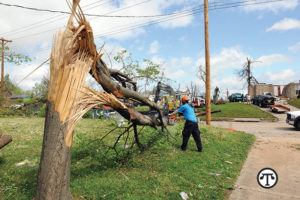Health, Home & Family
(NAPSI)—You may be feeling stressed during these challenging times, but stress can affect your physical and emotional health. Learn how to manage your stress so that you can stay healthy and cope with life’s challenges.
What is stress?
Stress is how your brain and body respond to a challenge. Any type of challenge—such as performance at work or school, a significant life change, or a traumatic event—can be stressful.
Your body reacts to stress by releasing hormones. These hormones make your brain more alert, cause your muscles to tense, and increase your pulse. In the short term, these reactions are good because they can help you handle the situation causing stress. This is your body’s way of protecting itself. However, too much stress all at once or over time (chronic stress) can threaten your health.
Everyone experiences stress from time to time, but your response to stress may be different. Some people may experience headaches or an upset stomach. Others may get muscle aches or chest pain. Stress can also disturb your sleep, reducing your energy and making it tough to keep active when awake. In addition, stress can lead to weight loss or weight gain. Over time, stress can contribute to serious health problems, such as heart disease, high blood pressure, diabetes, and other illnesses, including mental disorders such as depression or anxiety.
Managing stress through fitness, healthy eating, and relaxing activities
Regular physical activity, healthy food and beverages, and other positive activities may help you relieve stress and stay on track with improving your health.
Physical activity may help you start feeling better right away. It can help boost your mood and improve your sleep. In addition, physical activity adds to strength and stamina, which can help you manage stressful situations.
Physical activity doesn’t have to mean long workouts. Short workouts, such as a set of sit-ups or stretches, can help relieve stress. Try adding a new activity to your daily routine, such as walking around the block or up and down stairs a few times. Partner with a friend or neighbor to help you stay on track.
Consuming healthy meals, beverages, and snacks in moderation can be another way to protect yourself against stress. Preparing or purchasing foods such as whole grains, fruits and vegetables, low-fat proteins, and foods without added sugars or fats can give you energy and keep you feeling good.
Learn to recognize what triggers your stress response and identify ways to help you manage it. Other ways to help you manage stress may be to meditate, engage in your favorite hobby, limit your time on social media, volunteer, or connect with people who can provide emotional support.
Visit the National Institute of Diabetes and Digestive and Kidney Diseases website to learn more about physical activity, healthy eating, adequate sleep, and other behaviors to help you manage your stress. Visit the National Institute of Mental Health website to learn more about stress.
 by Samantha Clayton, certified personal trainer
by Samantha Clayton, certified personal trainer
(NAPSI)—For many people, social distancing brings concern about summer plans. In previous years, summertime was when families planned their vacations. The kids would be out of school, the weather could be fantastic, and the days are longer—allowing optimal time to venture to new places, catch some sun and spend more time with friends and families.
Since you may have already been spending a lot more time with your family then you ever imagined due to coronavirus outbreak, you may be looking for ways to keep your family entertained. Between possibly working from home, managing your kids’ schoolwork and maintaining a functioning household, this time probably hasn’t felt much like a vacation.
Social distancing guidelines are likely to remain in effect in many places during the summer. Activities and entertainment options, lodging, and dining will be affected. The good news is, you really don’t have to totally give up on enjoying the summer at home with your family. Here are some tips to make your staycation exciting for the whole family: Continue reading
 (NAPSI)—According to Darrell Smith, executive director of the International Window Film Association, window film makes a lot of sense for homeowners eager to save money on their energy bills.
(NAPSI)—According to Darrell Smith, executive director of the International Window Film Association, window film makes a lot of sense for homeowners eager to save money on their energy bills.
“Solar-control films can block as much as 80 percent of the solar heat coming through glass into a building, decrease the heat load on the air-conditioning system and reduce energy costs,” Smith says.
With more people working and studying from home, window film allows in abundant natural sunlight while blocking 99 percent of the sun’s harmful UV rays to better protect the skin (from possible cancer) and eyes (from cataract development), while reducing the fading of floors and furnishings. Smith estimates that 40 to 60 percent of color fading is caused by UV exposure. Windows may also be upgraded for safety, as window film helps to hold glass pieces together if the window is impacted and broken.
For even a 3,000 square foot home, window film may be installed in a day or less with minimal disruption. Window film installers clean the glass before installation, keep the work space clean and practice safe contact as recommended by the Centers for Disease Control. Find a local dealer/installer at www.iwfa.com.
 (NAPSI)—If you’re looking for a healthy start to your day, give California Sweet potato Blueberry Yogurt Muffins a try. Chock full of nutrient-dense ingredients such as blueberries, yogurt and whole wheat, these powerhouse muffins have a secret ingredient: shredded California sweet potatoes. A designated superfood, California sweet potatoes are loaded with vitamins, minerals and fiber. Plus, they keep the muffins moist and tender and add just the right amount of sweetness.
(NAPSI)—If you’re looking for a healthy start to your day, give California Sweet potato Blueberry Yogurt Muffins a try. Chock full of nutrient-dense ingredients such as blueberries, yogurt and whole wheat, these powerhouse muffins have a secret ingredient: shredded California sweet potatoes. A designated superfood, California sweet potatoes are loaded with vitamins, minerals and fiber. Plus, they keep the muffins moist and tender and add just the right amount of sweetness.
Bake a dozen (or more) and store in individual bags in the freezer for a healthy portable breakfast the entire household will enjoy.
California Sweet potato Blueberry Yogurt Muffins
Makes 24 regular or 10 jumbo muffins
4 large eggs
1 1/2 c plain yogurt
1/2 c butter, melted
2 tsp vanilla extract
2 c all-purpose flour
1 1/2 c whole wheat flour
2 c shredded sweet potatoes
1 c sugar
1 1/2 tsp baking powder
1/2 tsp baking soda
1/2 tsp salt
2 c blueberries
Preheat oven to 375° F. Coat muffin tins with nonstick spray.
In large bowl, whisk eggs, yogurt, butter and vanilla. In medium bowl, combine flours, sweetpotatoes, sugar, baking powder, baking soda and salt. Mix flour mixture into egg mixture. Gently stir in blueberries.
Divide batter between 24 regular or 10 jumbo muffin cups. Bake until golden brown and set, about 25 minutes for regular muffins or 30 for jumbo.
 (NAPSI)—Cleaner air can improve public health, maybe even save lives. Fortunately, renewable energy resources—wind, sun, hydropower and the like—are now producing more electricity than coal. That’s where innovative energy storage solutions come in. They help create a cleaner world, encouraging investment into clean, green, renewable energy. To help, engineers and policymakers are increasingly turning their attention to energy storage solutions. New bi-partisan efforts in states such as New York and the Trump administration are in alignment to support new energy storage technologies that drastically improve the economics of wind and solar projects.
(NAPSI)—Cleaner air can improve public health, maybe even save lives. Fortunately, renewable energy resources—wind, sun, hydropower and the like—are now producing more electricity than coal. That’s where innovative energy storage solutions come in. They help create a cleaner world, encouraging investment into clean, green, renewable energy. To help, engineers and policymakers are increasingly turning their attention to energy storage solutions. New bi-partisan efforts in states such as New York and the Trump administration are in alignment to support new energy storage technologies that drastically improve the economics of wind and solar projects.
The global rise in electricity generation from renewable sources has led to increased demand for advanced batteries that can be used to firm up this intermittent supply. This requirement is particularly important in areas where grid connections may be tenuous, unreliable or even non-existent. Additional demand for advanced batteries is presented by grid applications such as peak-shifting and Transmission and Distribution (T&D) capital deferral.
Energy storage systems provide many ways to manage the power supply for a more resilient energy infrastructure, and bring cost savings to utilities and consumers. Batteries allow the use of electricity whenever it’s needed, not only when it’s generated. However, traditional battery economics and performance have not proved helpful as utilities look to increase renewable penetration through long-duration energy storage.
The Problem
One of the challenges to growing a North American energy storage industry, however, has been a dependency on a supply chain of hardware components, metals and chemicals, many of which come from outside North America. As well, metals such as lithium and vanadium used in some batteries are impacted by price volatility and security of supply.
An Answer
Those same risks do not apply to zinc-air batteries. Zinc is abundant and inexpensive, with a significant North American supply. Its chemistry is robust and safe. A zinc-air battery has decoupled energy and power, making it one of the lowest-cost long-duration battery storage solutions available.
A safer, cleaner future requires less polluted air which means replacement of carbon-based power generation with renewable, sustainable sources of electricity. Long-duration, low-cost energy storage systems such as zinc-air will be a key driver to a quicker path towards a greener future. A “bet” on energy storage is a wager that will deliver a cleaner planet that will thrive for current and future generations, suggests Ron MacDonald, president and CEO of Zinc8 Energy Solutions, the leader in zinc-air battery technology, a unique flow battery technology using zinc and air as fuel.
Learn more
You can find further facts and stats on energy storage at www.zinc8energy.com.
 (NAPSI)—From a World War I veteran who lost both legs to a Vietnam vet suffering the effects of Agent Orange to a young Marine with post-traumatic stress disorder finding her way after returning home from Afghanistan—many of America’s veterans live with physical, mental and emotional injuries that impact their lives as a result of military service. They often need support with things such as navigating the complex Department of Veterans Affairs system to access veterans benefits, including health care and education benefits or identifying employment opportunities after military service. And because of their service-connected health conditions, they can be particularly vulnerable during health epidemics and economic downturns.
(NAPSI)—From a World War I veteran who lost both legs to a Vietnam vet suffering the effects of Agent Orange to a young Marine with post-traumatic stress disorder finding her way after returning home from Afghanistan—many of America’s veterans live with physical, mental and emotional injuries that impact their lives as a result of military service. They often need support with things such as navigating the complex Department of Veterans Affairs system to access veterans benefits, including health care and education benefits or identifying employment opportunities after military service. And because of their service-connected health conditions, they can be particularly vulnerable during health epidemics and economic downturns.
Fortunately, DAV (Disabled American Veterans) has been providing a century of care to help disabled veterans of all generations adjust to life back home. For the last 100 years, this nonprofit organization has offered a range of services from assisting veterans in accessing the benefits earned through their service to finding meaningful employment and supporting their families. DAV has continued to evolve and provide new care as veterans’ needs have changed. However, one tradition remains a constant: DAV’s services are provided to veterans and their families at no cost or obligation to them. Continue reading
Three Ways to Stay Connected to Your Senior Loved Ones While Social Distancing
After more than 45 days in lockdown, it’s no surprise that many people are going a tad stir-crazy. But it’s far worse for seniors: Not only have visits from their kids and grandkids been suspended, but there’s the extra stress that comes with the nagging suspicion that they’ll be advised to remain on lockdown long after younger people begin trickling back to work and the world starts opening up again.
In fact, the AARP Foundation has even come up with this dire comparison: Prolonged social isolation, for those aged 50 and older, “is the health equivalent of smoking 15 cigarettes a day.” Fortuitously, some of the niftiest technology offers solutions both to keep us connected and protect against some of the miscreants taking advantage of the situation.
- Health Checks. If you are worried that all of the anxiety is harming your loved ones’ overall well-being, the machine-learning algorithms that analyze activity data as part of Alarm.com’s Wellness solution can provide you with the very details you’ve suddenly found yourself obsessing about.
Did they open their medicine cabinet when they should, to take their prescription? Have their sleeping, eating, and (yes) bathroom patterns changed? Are they up and about during the day? Continue reading
(NAPSI)—According to the United States Department of Agriculture, in the U.S., more than 12 million children receive free or reduced-price breakfast at school, and more than 29.7 million get lunch through the national school lunch program. For many, school meals are the only consistent food they get in a day and, while many school districts have continued distributing meals during the pandemic shutdown, when the school year ends, so do school meals. But there is hope and help.
Nationally, companies and non-profit organizations are partnering to help meet the needs in the community. One such partnership between Herbalife Nutrition and Feed the Children, a nonprofit organization, aims at solving the issue of food insecurity. The two organizations have united under the shared commitment to defeat hunger worldwide.
The Importance of Nutrition
The most vulnerable members of our society, children, rely on school meals and feeding programs to survive. Families living paycheck to paycheck may not have savings or support systems to help them. When children are guaranteed proper health and sanitation measures, they are able to prevent and fight disease, enabling them to develop both physically and mentally into strong children who become contributing members of their communities. Continue reading
 (NAPSI)—Young men and those who care about them should consider the story of Max Mallory. At 22 he graduated from college and started his dream job in the video game industry. He landed the job before graduation at the company where he had interned for almost a year. Set up in his own apartment, he started to live his life on his own and navigate the nuances of that first professional job.
(NAPSI)—Young men and those who care about them should consider the story of Max Mallory. At 22 he graduated from college and started his dream job in the video game industry. He landed the job before graduation at the company where he had interned for almost a year. Set up in his own apartment, he started to live his life on his own and navigate the nuances of that first professional job.
Life was fine until mid-October, when Max experienced what seemed like stomach troubles and minor back pain. After two visits to urgent care centers where doctors prescribed antibiotics, he came home to stay with his dad and visit a urologist. He never made it to that medical appointment. Doubled over with sudden pain the next afternoon, he called 911. Late that evening in the emergency room, he heard the worrisome diagnosis: late-stage testicular cancer.
His cancer journey lasted only seven hard-fought months. He had an aggressive testicular cancer, choriocarcinoma. He passed away three days after he received the first round of stem cells.
He couldn’t have prevented his testicular cancer with self-exams, since he “was born with” one testicle that was healthy. Continue reading

SAINT LOUIS, MO – APRIL 22: Clean up after the destruction left behind by tornadoes that ravaged the area. April 22, 2011 in Saint Louis, Missouri
(NAPSI)—The preparations you make now, ahead of storms, floods or hurricanes, can help you recover faster and stay safe during cleanup. The Outdoor Power Equipment Institute (OPEI), an international trade association representing manufacturers and suppliers of power equipment, small engines and battery power, utility and personal transport vehicles, and golf cars, reminds home and business owners to get ready before a storm strikes and make preparations now.
“Weather can be unpredictable, so itís important to always keep your equipment in working order, to have the right fuel on hand and to know where your safety gear is. This is doubly true during storm season, as the weather can change quickly,” said Kris Kiser, president and CEO of OPEI. “You also want to know how to use your equipment safely and use caution when cleaning up.”
These tips can help homeowners and businesses plan ahead for storm cleanup:
- Take stock of your outdoor power equipment. Make sure it’s in good working order. If needed, take the equipment to an authorized service center for maintenance or repair. If you need to buy a new piece of equipment, get it before the storm and learn how to use it.
- Find your safety gear. Avoid the scramble for sturdy shoes, safety goggles, hard hats, reflective clothing and work gloves, which should be stored in an accessible area with your equipment.
- Review the owner’s manuals. Read product manuals to ensure you know how to operate your equipment safely.
- Have the right fuel on hand. Fuel stations may be closed after a storm. Store your fuel in an approved container. Use the type of fuel recommended by the equipment manufacturer. It’s illegal to use any fuel with more than 10% ethanol in outdoor power equipment (for more information on proper fueling visit www.LookBeforeYouPump.com).
- Charge batteries. Collect the batteries for your outdoor power equipment and fully charge them ahead of the storm.
- Use safety precautions. Be aware of fundamental dangers that can occur. For instance, chainsaw kickback may happen when the moving chain at the tip of the guide bar touches an object or when the wood closes in and pinches the saw chain in the cut. Always stand with your weight on both feet, and adjust your stance so you’re angled away from the blade. Hold the chainsaw with both hands. Never over-reach or cut anything above your shoulder height. Have a planned retreat path if something falls.
- Ensure portable generators have plenty of ventilation. Generators should never be used in an enclosed area or inside a home or garage, even if the windows or doors are open. Place the generator outside and away from windows, doors and vents that could allow carbon monoxide inside. Keep the generator dry. Do not use it in rainy or wet conditions. Before refueling, turn the generator off and let it cool down.
- Drive Utility Type Vehicles (UTVs) with caution. Keep the vehicle stable and drive slowly. Do not turn the vehicle mid-slope or while on a hill.
- Be aware of others. Keep bystanders, children and animals out of your work area. Don’t let other people near outdoor power equipment when starting or using it.
- Pay attention to your health. Storm cleanup can be taxing on the body and the spirit. Don’t operate power equipment when you’re fatigued. Drink plenty of water and take regular breaks.
Keep this advice in mind and you may be better prepared to weather any storm.

